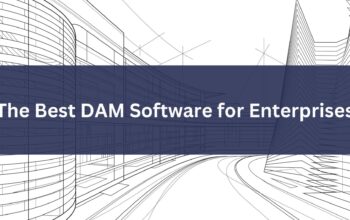In an age where everything is digitalized, the volume of content created, shared, and stored has risen exponentially. From photographs to documents, presentations to videos, digital assets are the building blocks of our online world. However, with the growing use of digital assets, a traditional media bank or cloud storage can not solve many of the challenges faced with managing such digital assets.
This brings to light the importance of a Digital Asset Management (DAM) system – a specialized platform that helps organizations control, manage, and streamline the use of these assets in various stages of their lifecycle.
A DAM solution isn’t just about storage; it’s about ensuring that the right asset is available in the correct format at the right time and to the right stakeholders, making workflows efficient, and maintaining the integrity and value of digital assets over time.
But, as with any evolving discipline, there are challenges along the path to perfecting and implementing effective DAM strategies. In this blog, we’ll discuss some of the most common challenges faced in DAM and, more importantly, provide insights into how these challenges can be solved so you can begin your DAM journey with ease.
Common Challenges in DAM
With the growth of digital assets in your organization and the need to maintain them organized and accessible, a DAM solution is necessary. However, dealing with the challenges that come with a DAM can become difficult.
Organizations need to tackle these digital asset management challenges to fully enjoy the benefits of their DAM system. Here are the common challenges (and solutions) associated with digital asset management:
1. Making the Transition to DAM
As is the case with most new technology, the adoption and efficient use of DAMs come with their own set of challenges. Once an organization decides to adopt a DAM system, the transition from traditional workflows to fully embracing the capabilities of DAM can be complex.
This may cause some hesitancy in transitioning to a DAM. Employees accustomed to specific workflows might resist implementing new systems, especially if they perceive the change as adding to their workload or complicating their tasks.
Like any new technology, DAM systems come with a learning curve and some team members might find it difficult to familiarize themselves with new software, particularly if they aren’t tech-savvy.
Solution
Begin by comprehensively understanding the historic workflows. Documenting and analyzing these processes will provide clarity on what needs to change and why. To do this, make sure to create an open space and get feedback from the team, taking the time to understand where pain points and gaps exist.
Next, Ensure that everyone understands the reasons behind the transition to DAM, the benefits it will bring, and how it will impact their roles. Continuous communication will help ease any fears and resistance.
Make sure to organize comprehensive training sessions to get users comfortable with the new system. This should include hands-on tutorials, Q&A sessions, and providing resources like user manuals or online help guides.
Lastly, before a full rollout, consider running a pilot test with a select group. Oftentimes, this group is the marketing team or business development team. This allows you to iron out any issues, gather feedback, and make improvements based on real-world usage.
| TIP: With 63.2% of marketing teams dedicating more than half of their time to proposals, it’s crucial to understand where bottlenecks exist and how to optimize your workflow. Download The State of Proposals in AEC Marketing Report now and take the first step towards improving workflows and overall proposal strategy. |
Make sure your DAM provider is there to help you every step of the way, including before, during, and after implementation. They should offer an onboarding team, a support team, and a customer success team who work as your strategic partners as you continue to use, adjust, and contribute to your DAM system. Additionally, they should offer training sessions designed to provide you with the knowledge and tools to use their DAM solution.
2. Asset Discovery and Organization
Businesses frequently face challenges controlling and organizing their digital asset management (DAM) system. The absence or inconsistency in standards for storing, organizing, and tagging assets often makes it difficult for the user to locate required assets. This can result in duplicate assets, complications with asset versioning, and spending additional time locating the right assets.
Using a traditional folder system typically requires you to know the exact location of an asset to access it. For instance, if you’re searching for the company’s most recent InDesign template, it can be challenging if you don’t remember if it’s located within the “InDesign,” “Design Assets,” or “Business Templates” folder.
Having your files, projects, and employees all connected gives you a comprehensive overview of your projects so you can quickly find your assets.
Solution
To overcome the challenge of asset discovery and organization, you need effective file management by implementing a consistent and organized folder structure. These folders must be stored in a single, central repository, like a DAM system.
With proper metadata tagging and the use of automated tagging tools, DAM provides team members with diverse methods to search for content, moving beyond the limitations of rigid folder frameworks.
Metadata, essentially the data about your data, is crucial to any DAM system. By organizing digital assets with metadata, users can easily search for assets using relevant keywords or use custom taxonomies to filter out unrelated file formats or categories.
| TIP: Unlock our State of AEC Marketing Report and get insights into current marketing challenges in AEC, and actionable strategies for success. |
3. Version Control
In a DAM system, it’s common to have many different versions of the same file, like a logo or document. Throughout an asset’s lifecycle, there might be numerous updates, edits, or modifications. Each significant change may result in a new version of the asset being saved.
The problem is, that using an old or wrong version by mistake can cause issues. For example, you might share outdated information or use an old company logo. For brands, this might mean risking displaying inconsistent messaging or visuals to the audience. And for internal documents, you risk using outdated information that can lead to misinformed decisions.
Solution
A solution to this problem is implementing version control systems. By using a DAM system that automatically handles version control for digital assets, every modification to a digital asset should be recorded as an updated version. Version control allows for tracking the asset’s revisions and understanding its development over time.
Clearly labeling asset versions allows users to quickly identify the most recent and relevant version of a digital asset. This helps reduce confusion and potential errors.
Moreover, establishing clear approval workflows ensures that assets meet the required standards before they are finalized and distributed. It minimizes the risk of inaccuracies and ensures quality control.
4. Scalability
Another DAM challenge is not having the desired scalability. Many businesses get to a point where they have to manage an ever-growing volume of digital assets. This consistent growth may result in their current systems struggling to accommodate it. Therefore, ensuring system performance doesn’t degrade and maintaining efficiency may become a challenge.
Moreover, the responsibility of the IT department intensifies when ensuring the servers and infrastructure can scale with the demands of a DAM system managing large (and growing) quantities of assets.
Solution
Modern DAMs should empower you to scale your asset operations. With scalable storage options, as your number of assets grows, storage can be increased seamlessly without interrupting the user experience.
With a cloud-based DAM solution, not only can assets be accessed from anywhere, but platforms can adjust to support growing asset volumes, ensuring there’s always enough space and resources. Additionally, instead of investing in physical hardware, companies can adjust their subscription plans based on their current needs.
Moreover, regularly updating the DAM system ensures it runs efficiently, even as the volume of assets grows.
By choosing a cloud-based DAM solution with flexible storage options and regular system maintenance, the system will likely adapt to your company’s needs and evolve as your organization grows.
5. User Permissions and Security
DAM systems often deal with a huge volume of assets, some of which might be sensitive or proprietary. For this reason, ensuring that the right people have access to the right information without compromising security is vital. However, finding the right balance between giving the necessary access to maintain efficiency while ensuring assets are secure is a constant challenge.
As organizations grow and roles change, determining access levels becomes complex. Your DAM system should allow you to assign specific permissions based on user roles or departments. With multiple users accessing and possibly modifying assets, tracking changes and ensuring accountability can be difficult.
Moreover, ensuring that assets, especially those of a sensitive nature, are encrypted and securely stored is essential. This requires both robust software and hardware measures.
Solution
To tackle the challenges of user permissions and security in a DAM system, you can use role-based access control to grant access to assets based on the user’s role within the company. For example, editors might have the ability to modify assets, while viewers can only see them. This minimizes the risk of unauthorized changes and ensures that only relevant staff can access specific assets, enhancing both security and workflow efficiency.
Moreover, you should use strong encryption protocols for storing and transmitting data. Couple this with secure authentication methods, like two-factor authentication or single sign-on, to ensure only authorized individuals gain access. This protects sensitive or proprietary assets from breaches and unauthorized access, giving organizations peace of mind about their digital content’s security.
Lastly, conduct regular security audits of the DAM system to check for security gaps, outdated protocols, or any other potential risks. Regular audits ensure that the system remains up-to-date with the latest security standards. They can catch potential vulnerabilities before they become serious issues, ensuring the ongoing protection of assets and user data.
6. Integration With Other Tools
It’s essential to have a DAM system that offers various popular DAM integrations tailored to your firm’s needs. This will allow you to access, manage, and edit your digital assets all in one DAM system. However, ensuring that the DAM system seamlessly integrates with other necessary tools in the organization’s tech stack can be technically challenging, mainly if those tools are older or less standard.
Integrating with other software tools shouldn’t be difficult. But, not all software tools are built with compatibility in mind. Integrating distinct systems can require custom solutions, which can be time-consuming and expensive.
Moreover, there’s the risk of siloed data and inefficient workflows. If not properly integrated, data can become fragmented across multiple platforms. This means teams might not always have the latest or most accurate version of an asset. Without smooth integration, tasks like data entry might need to be repeated across systems, wasting time and increasing the chance of errors.
Solution
Strategies to help improve integration with other software tools include using API integrations, selecting DAM systems with open architecture, and training staff on integration best practices.
APIs allow different software systems to communicate with each other by defining methods and protocols. Identify and use robust APIs that can bridge your DAM system with other tools. This will ensure real-time synchronization and seamless data transfer between platforms.
Additionally, open architecture systems are designed to be modular and adaptable, making it easier to integrate them with other software. When choosing a DAM system, prioritize those built on open architectures. They often come with pre-built integrations or allow customizable integration options.
Lastly, ensure the team understands the importance of integrations and knows how to utilize them effectively. To do this, organize regular training sessions where staff are taught how the integrations work, the benefits they bring, and best practices to avoid common pitfalls.
Best Practices for Overcoming Common DAM Challenges
Now that we’ve looked at challenges ranging from resistance to change and integration issues to scalability concerns, it’s time to look at how we can solve such problems so you can make the most out of your DAM system.
The good news is that by following these best practices, the challenges mentioned can not only be avoided but turned into opportunities for added collaboration and efficiency. Here are our best practices for overcoming DAM challenges:
Conducting a Needs Assessment
Before jumping into any solution, take a step back to assess what your organization truly needs. Consider factors like the volume of assets, user access needs, integration requirements, and growth plans.
Engage with various teams to understand their challenges with the current system. This could include difficulties in finding assets, versioning issues, or even challenges in uploading and categorizing assets.
Choosing the Right DAM Solution
When looking for the best digital asset management software, it’s important to find one that aligns with your organization’s specific goals. Investing in unnecessary features is not only a waste of resources but can also complicate the user experience. By understanding your team’s specific needs for the DAM, you can simplify the selection process.
Once you have a clear understanding of your needs, research and evaluate DAM solutions that align with those requirements and stay within your digital asset management cost requirements. The chosen DAM solution should not only cater to immediate needs but also align with the long-term goals and vision of your organization.
Choosing the appropriate DAM software can be overwhelming, yet the rewards from the effort made are significant. A top DAM system can boost efficiency and elevate business growth to new levels.
| TIP: Still confused about what to look for when choosing the right DAM solution? Read our DAM Software Buyer’s Guide now for more information on how to compare DAM software. |
Creating a Metadata Strategy
Having organized and detailed asset metadata is essential for smooth DAM management. Simply put, metadata categorizes content and drives the process of searching and finding assets. A simple and clean metadata strategy makes searching and categorizing assets a breeze.
To be successful, we highly recommend meeting with different departments to ensure the metadata schema is widely relevant and intuitive for all teams. Once the schema is in place, ensure that everyone who uses the DAM is trained on how to apply metadata as they upload assets.
Appoint a specific team responsible for collaborating and making important decisions regarding the metadata structure. This team will ensure uniformity and relevance in the applied metadata.
Moreover, establish periodic checkpoints to assess the efficacy of the current metadata strategy. These reviews will provide insights into what works and what doesn’t, allowing for timely adjustments and improvements.
Implementing Training Programs
Training is essential for helping users learn how to use a DAM system and leverage its features. After all, a DAM system is only as effective as its users. To optimize the efficiency of a DAM system, ensure all users understand the DAM system and conduct ongoing training sessions. All users must have a comprehensive understanding of its operations and best practices.
Regular training ensures that everyone knows how to best use the system, optimizing its potential. Moreover, with each important DAM feature update or new workflow, continuous training keeps everyone on the same page.
You should have a straightforward training process to determine the following:
- What projects or content will be stored in the DAM system?
- When does it get uploaded?
- How does it get uploaded?
- Who is responsible for these tasks?
Additionally, as mentioned earlier, look for a DAM provider that offers ongoing support and training for end-users. You’ll want to choose a DAM company that has dedicated teams to help you succeed throughout your entire DAM journey.
Regular Maintenance and Monitoring
Keep a close eye on system performance metrics to ensure that it meets user needs and operates efficiently. To keep an eye on your DAM system, you should use the right tools and reports. Make use of the built-in analytics, dashboards, and alerts.
Create or adjust reports based on what you aim to achieve. Regularly look over these reports, share them, and act on what they suggest. This will make your DAM system work better and be more valuable.
DAM is all about how often and how well your company uses its digital assets. Therefore, you should also regularly audit the assets in the DAM for redundancy, accuracy, and relevance.
You need to check how often these assets are seen, used, or shared internally and externally. Understanding how these assets help your business can help you better manage these assets and get more value from them.
Additionally, ensure that the software is regularly updated to benefit from the latest features and security enhancements.
User Feedback and Collaboration
Training and giving your users a voice can be very beneficial. An open channel for users to voice concerns, give feedback, or suggest improvements can lead to continuous improvement of the DAM process and keep your users involved.
Create ways for them to share their thoughts, ideas, or problems related to your DAM process – what works for them, what doesn’t, and what they’d like to see. You can gather their input using surveys, chats, or group discussions.
Regularly ask for their feedback and address it quickly. Valuing their feedback creates a culture of ongoing growth and improvement. This way, you not only improve the system but also make users feel important and listened to. Plus, by encouraging them to communicate and collaborate on digital assets in your DAM or other tools, you promote teamwork.
Additionally, for a DAM system to be truly successful, it needs to be embraced at all levels. Involving all stakeholders in key DAM decisions ensures broad acceptance and aligns the DAM strategy with organizational goals.
Case Studies
All of this might seem easier said than done. However, our success stories prove that many companies have faced these issues and come out on top. All it takes is working with a DAM partner that understands your needs and will support you. From onboarding to adding new integrations, here’s how we help teams make file sharing simple.
- Architecture: Hear how CannonDesign received “phenomenal customer service support” as they merged multiple file libraries with Openasset.
- Engineering: Affiliated Engineers made data migration look easy with the help of OpenAsset’s keywording structure and support.
- Construction: HBW managed projects and built construction presentations with ease after implementing OpenAsset.
Next Steps
As we’ve seen, managing digital assets well is essential for businesses. DAM simplifies the process of streamlining assets, ensuring businesses can quickly find, access, and share their assets. This efficiency isn’t just about organization—it directly impacts productivity, security, and even profit.
This article highlighted common problems with DAM systems and how to solve them. The challenges presented— from asset discovery to scalability issues — show that with the right DAM provider and team, these challenges can be easy to solve.
By tackling challenges in DAM with the best practices we outlined, like tagging items properly, choosing the right system, and listening to user feedback, businesses position themselves for success. If you want your business to remain competitive, finding the right DAM partner and taking the steps to improve your DAM practices is a must.
At OpenAsset, we’re the industry’s leading digital asset management designed specifically for AEC and real estate professionals. We combine the most vital features, tools, and partner integrations that your AEC firm needs into one seamless platform. Plus, we offer ongoing support and training resources so you can feel confident storing and managing your files, even after implementation.
If you’re still searching for the right DAM, review our DAM Buyer’s Guide Checklist. For expert guidance tailored to your team’s needs, reach out to our asset management experts to schedule a demo. Experience for yourself how a DAM solution can improve your file sharing and management with endless creative benefits.





